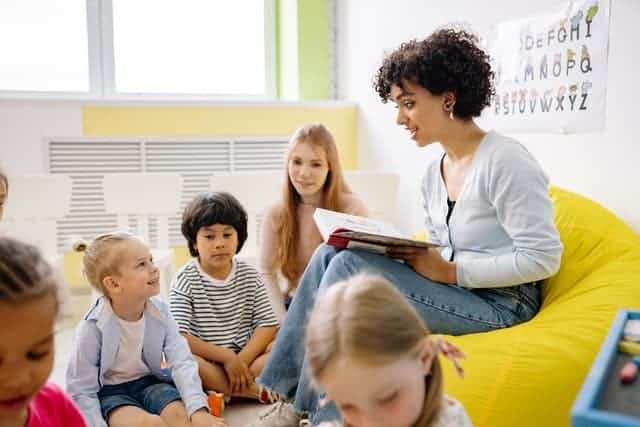When you have respect for someone, you admire them for their abilities, qualities, and achievements. Respect is something that individuals crave. Both inward respect, toward self, and outward respect, toward others are essential in creating thriving environments.
Respect can be taught in an emotionally positive way at home and in a classroom setting.
According to the Stanford Encyclopedia of Philosophy, “Respect has great importance in everyday life.” (Stanford). Respect for oneself and for the community can have a profound determining effect on a child’s development. The Stanford Encyclopedia of Philosophy goes on to say that, “how our lives go depends every bit as much on whether we respect ourselves.” As educators, it’s of high importance to include learning opportunities in curricula that give students tools to learn to respect themselves and their communities.
Teaching respect in the classroom through activities is worth the effort. When children learn to respect differences, it benefits them for the rest of their lives. At Soul Shoppe, we have an entire curriculum available online for grades K-6 that’s dedicated to teaching how to respect differences. Click for more information.
In addition, we’ve put together a list of games to help get you started.
Respect Games for Students
Everybody is Unique (EducationWorld)
This game is appropriate for grades K-8. The basic premise is to create positive emotional relationships with the things that make people different from each other.
Materials:
- Paper
- Art supplies
Method:
- Begin by writing the word “Unique” in some prominent place in your classroom–chalkboard or on a big piece of paper on the wall.
- Students write down positive aspects of other people that are different from themselves. Emphasize choosing unique characteristics that they like.
- Lead a discussion on these unique characteristics. Talk about why differences are important and good.
Compliment Journal (Drake)

For this game, students will systematically get in the habit of using positive language in their interactions and will try to find positive features in other people.
Materials:
- A journal for every student.
Method:
- Every day for a week, students will give a sincere compliment to someone.
- They will create a weekly planner with the provided journal and track their progress.
- Every day they track who they complimented, who complimented them, and how they reacted.
Simon Says “Who are You?” (Education World)
This game encourages students to celebrate their differences and similarities.
Material:
- None
Method:
- Play Simon Says, but form Simon’s Instructions by mentioning some features people sometimes share.
- “Simon says, everyone with long hair, stand up.”
- “Simon says, everyone who likes cats, touch your head.”
What Respect Sounds Like (AliciaOrtega)
The purpose of this game is to encourage children to imagine respectful behaviors in their lives outside the classroom.
Material:
- Flashcards
- Markers
Method:
- Prepare cards ahead of time with words corresponding to respectful human traits and behaviors:
- Saying, “Thank you.”
- Sharing your chips.
- Asking to leave.
- In the classroom, ask your students to sort the flashcards into two piles:
- What respect sounds like.
- What respect looks like.
Respectful Stories (Drake)

Movies and books are good teaching tools if they’re used right. Stories are places where children can interact with hard ideas in a safe environment.
Materials:
- A book or half-hour TV show
- Notebook and pencil (optional, but useful for keeping discussion organized)
Method:
- Watch the show or read the book with the students.
- Take notes during the show or book.
- After watching the show or reading the book, have an organized discussion.
- Ask, “who was respectful?” “Who wasn’t respectful?”
Respectful Vocabulary (Drake)
Understanding more words about a subject helps students comprehend and use the lessons to a higher degree. In this game, students will learn synonyms for and terms related to “respect.”
Materials:
- Dictionary
- Construction paper
- Markers
Method:
- All students look up the word “respect” in a dictionary.
- They will find at least ten synonyms or terms related to the word “respect” or “respectful.”
- Everyone writes down the terms they’ve looked up on strips of construction paper.
- Now make a chain from all the strips. Celebrate every foot in length the chain accumulates.
Teaching Respect in the Classroom
This is far from an exhaustive list of respect activities for elementary students that educators might incorporate into curricula. Games like these take time, but they engage students on multiple levels and encourage them to internalize ideas and practices encouraging respect in and outside of the classroom. These activities can also be used by parents when homeschooling.
Teaching respect helps to promote cooperation and acceptance. The classroom is the place that children associate with learning important lessons to prepare them for success in life. Therefore, it’s the perfect place to incorporate activities on respect.
Soul Shoppe provides social emotional learning programs. For more than twenty years they’ve been devoted to creating tools and empowering educators of all stripes to incorporate emotional intelligence into their curricula. Their strategies are effective in encouraging empathy and emotional awareness in children. Click for more information on SEL Programs for Elementary Schools. Click here for the respect differences online program.
You May Also Like:
Conflict Resolution Activities for Kids
Virtual Social Learning Activities
How to Teach a Child to Take Responsibility for Their Action
How To Teach Empathy To Kids and Teenagers
How To Express Your Feelings in Words


